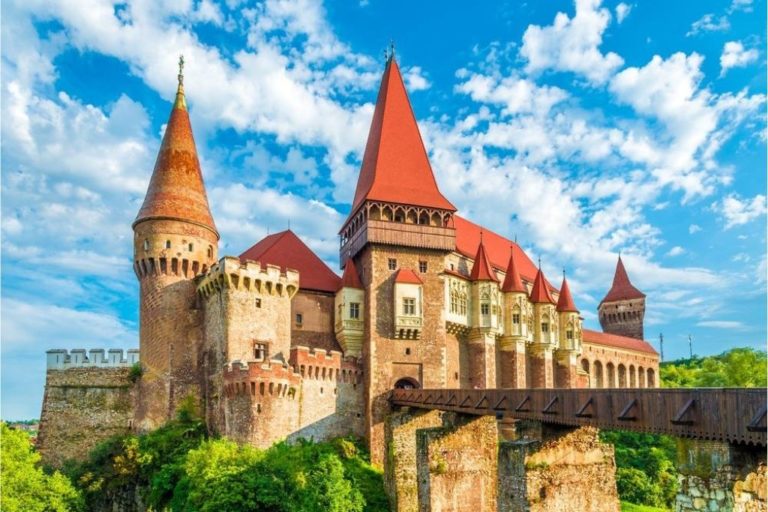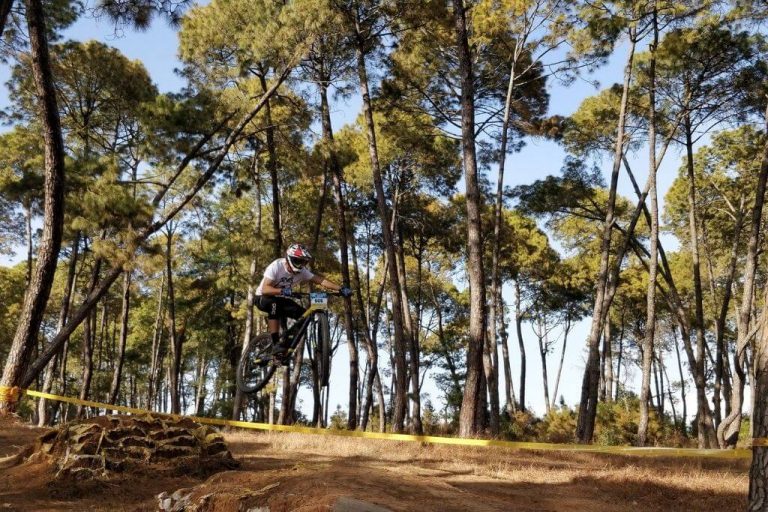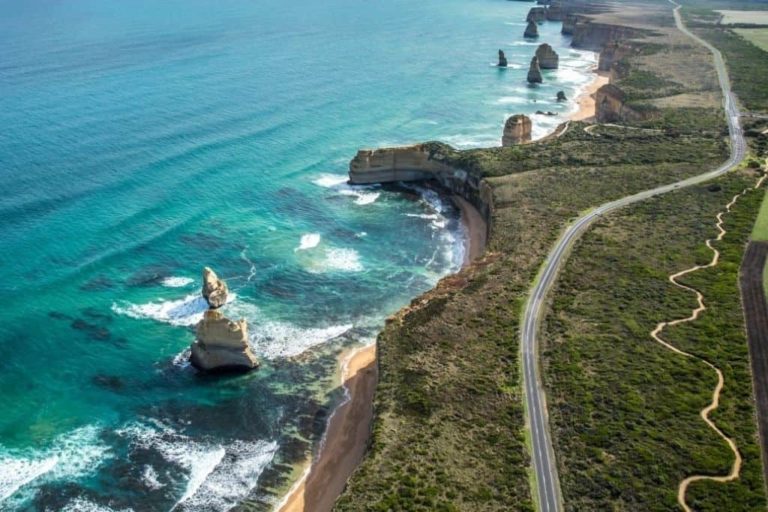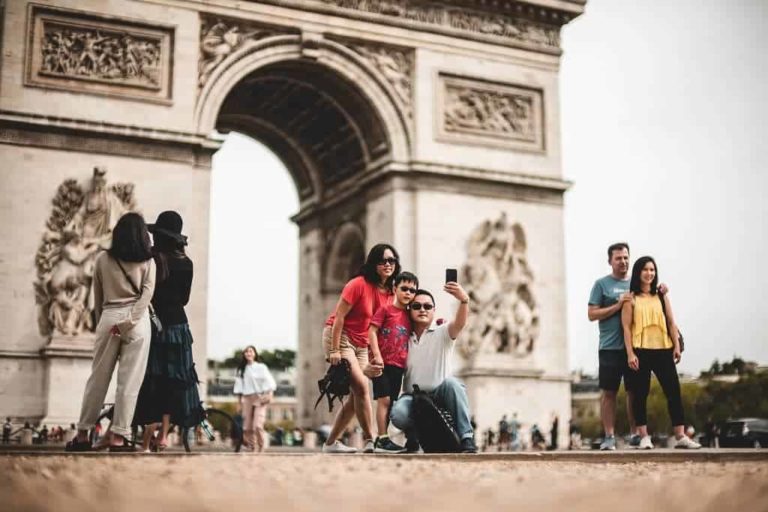Kathmandu—the capital city of Nepal, is the center of the country’s history, art, and economy. It is a city with a lot of history, from several kings and queens to interesting legends about demons and gods. It is truly a modern city that comes alive with its ancient values and culture.
It falls in the central region of Nepal, situated at 1,296 meters above sea level. It is a political, cultural, and economic hub of the nation. No wonder people from across the country travel to Kathmandu and get lost in the city’s fast-paced life.
It is a diverse city that houses more than 1.7 million people of multi-ethnicity. You will find many religious and cultural festivals going on all year round in Kathmandu.
With numerous monuments, heritage sites, and places suitable for outdoor adventure, it challenges all Southeast Asian cities to provide a complete experience.
Kathmandu attracts visitors with its attraction sites that have exquisite architecture. Some are the carved wooden windows, pillars, and bronze sculptures on every stupa.
The city is the most urbanized of all the cities in Nepal. With the beauty of traveling comes the hustle and bustle of the city. And with urbanization comes the facilities.
Kathmandu has Nepal’s finest hotels, eateries, and transportation services. Sure, some may not match the level of other developed countries. But mind you, it has the best ones for developing countries.
It is also a safe city to travel around. You only need to be careful about the pollution and noise. Plus, travel in a group or with someone at night for your safety.
But no matter what, one thing to love about them is their hospitality. Every person you will meet in the city will greet you with a smile and always welcome you.
It is the gateway to your ultimate Himalayan tour. It is where you will be landing first on your visit to Nepal. From here on, you will explore the mighty Himalayas or Terai wildlife.
I suggest you spend 2-3 days or a week in Kathmandu before or after visiting the other cities. Read more to know why.
History of Kathmandu
‘Kathmandu’ comes from the word ‘Kastamandap,’ which means ‘Wood Pavilion’ in Sanskrit. The pavilion stood in Durbar Square. It was rebuilt in 1589 AD during the reign of Laxmi Narsingha Malla.
Legends have it that the timber used to build the Kastamandap pagoda was obtained from a single tree. The history of Kathmandu’s origin has two parts: legends and written records.
Legends
According to famous legends, present-day Kathmandu was once a vast lake full of snakes. People called it the ‘Nagdaha.’
A Bodhisatwa named Manjushree cut the hill of Kirtipur and drained the water with his sword. After exhausting all the water, he established the city and made Dharmakas the ruler.
Another legend is that after the valley was established, a demon named Banasur apprehended it. He also closed the outlet from where the water drained.
Then, the Hindu God, Lord Krishna, and some Gopalas came to Nepal and killed the demon. He restored the valley and made Bhuktaman the king of Nepal.
Records
There are few historical records about who ruled Kathmandu before the medieval Licchavi Dynasty.
According to a genealogical record of Nepal Monarch Gopal Raj Vansawali, the Gopalas were the first to make Kathmandu their habitat. Then, Mahispals and Aabhis ruled the valley.
It was in the reign of Yalamber that the Kirati Dynasty was established. Settlements called Yambhu and Yengal were set up in the north and southern half of the valley.
During the Kirati reign, Buddhist monks entered the valley. They established a forest monastery at Sankhu.
The Licchavi king, Gunakamdev, had defeated the Kirati Dynasty around the 9th century. After that, the city was founded again in the pages of history.
During this era, the Shakyas, who survived the genocide in Lumbini by Virudhaka, migrated to Kathmandu. There, they established the first permanent Buddhist monastery in Kathmandu. It is how the Newar Buddhism Society came into existence in Nepal.
Economic History
Kathmandu was the transit point of the Tibet-India trade route. It is the reason that helped the growth of urbanization in present-day Kathmandu.
The Malla Era, Rana Rule, and Shah Rule followed the Lichhavi Era. During the Malla reign, the city flourished in terms of art and architecture. The famous Durbar Squares of Kathmandu, Bhaktapur, and Patan were also made.
In the 1950s, tourism began to flourish in Nepal. From the late 60s, Kathmandu was a hub for hippies and backpackers from all around the world.
The main reason was its natural beauty. And we should not forget the availability of marijuana and hashish.
In the current situation, Nepal has made marijuana use illegal. However, the country still invites many travelers every year. People mainly come here to trek the Himalayas or sightsee wildlife.
Useful dialects in Kathmandu
Nepali is the mother tongue of Nepal. You can buy a translation book from stationery shops. But here are some essential words that you can use:
Greetings/Hi/Hello: Namastey
Thank you: Dhanyawaad
Help: Sahayog
How much? /Price please: Paisa kati bhayo?
Yes: Huss
No: Nai
English and Hindi are also widely spoken and understood in Kathmandu.
When is the best time to visit Kathmandu?
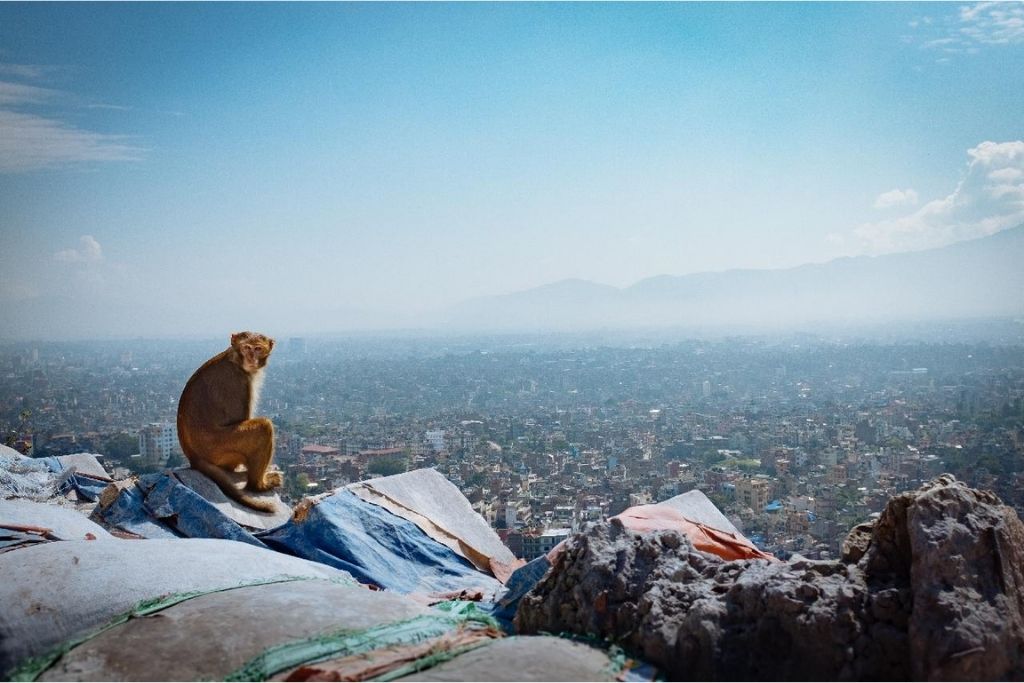
The best time to travel to Kathmandu and Nepal is in the post-monsoon season. That is from October to December. These are the months when the monsoon rain clears out the dust. It makes way to the perfect view of the Himalayas and the blue skies.
October to December has the perfect weather for sightseeing and traveling cross country. These are the peak season to travel to Kathmandu as well. Spring Season (February to April) is also an excellent time to visit Kathmandu. There can be low visibility of the scenery, but you will face good weather.
AVOID the monsoon season, which lasts from June to August.
Currency
Kathmandu uses the Nepalese currency (NPR) for its transactions. There are many foreign exchange offices all over Kathmandu. Like most travelers, if you are staying in Thamel, it has many foreign exchange offices. Those offices will readily change your dollars for Nepalese currency.
Many ATM Lounges in Kathmandu accept foreign cards, too. Some shops in Kathmandu also receive Indian currency.
Traveling to Kathmandu
Nepal has only one functioning international airport until now. Luckily, it is in Kathmandu. So book a flight straight to Tribhuwan International Airport, Kathmandu, from your home.
Visa: For most foreigners, Nepal will issue your visa on arrival at the Tribhuwan International Airport.
You can purchase it for 15, 30, or 90 days, depending on how long you plan your stay here. The visa will cost you anywhere from $25 to $100.
All you need to do is bring a passport-sized photo and stand in a queue to pay for the visa upon your arrival at the airport.
If you come from India, you can travel via airplane, tourist bus, jeep, or car. However, the trip to Kathmandu can be very tiresome by road.
How to travel around Kathmandu?
Traveling around the city is easy. There are a lot of options you can choose from according to your needs and budget. Local transportation is available across the city and has its route.
Local Buses
Buses are by far the cheapest way to get around in Kathmandu. But here’s a warning: You will have to experience the chaos of Kathmandu.
The buses will be packed, and drivers will drive it like a race car on a race track. The only difference is it is not a race car, and the race track is a jam-packed road.
You will find local buses outside the Thamel area, like Kantipath and Ratnapark.
Fare: NPR. 20 / $0.17
Micro-Bus
Micro-buses are minibusses that carry 12-15 people.
They are faster and more comfortable than buses. I suggest hiring a private HIACE microbus to tour the city if you are traveling in a group.
Trust me. It will be the best spend because not only is it comfortable, but it also has an air conditioning facility. Plus, it will stop wherever you want.
Fare: NPR 20 / $0.17
Tuk-Tuk
Tuk-tuk or electric tempo is a great way to travel around the city. They are a bit slow, but they are safe and eco-friendly.
Fare: NPR 20 / $0.17
Taxi
Taxis are the easiest and the most comfortable way to get around Kathmandu.
You can stop whenever you want and do not even have to walk to the attraction spot. The taxis will take you to the exact location that you wish. They do not follow a specific route like other public transportation.
Be sure to negotiate the fare, as the drivers always try to charge you higher prices.
Fare: Anywhere from NPR 100 – NPR 500 ($0.86 – $4.28), depending on the distance and your bargaining skills.
Rickshaw
Taking a rickshaw ride is the best option if you want to stroll around the Thamel and Durbarmarg area.
It is a great way to sightsee and take pictures on your way. The only lousy perk is that Rickshaws are unavailable in all parts of Kathmandu. It is due to the chaotic traffic and pollution of the city.
Kathmandu also has online transportation applications where you can hire a ride on a bike or a taxi. Apps like Tootle and Pathao will get a lift and rider to take you to your location.
The vehicles include a motorcycle, scooter, and taxi only.
Places to Visit in Kathmandu
The Durbar Squares
There are three Durbar Squares in Kathmandu, and visiting each is a must on your tour to Kathmandu. All these Durbar Squares are on the UNESCO World Heritage Sites list.
These Durbar Squares served as palaces to three kingdoms of Nepal. They are—Basantapur (Kathmandu), Patan (Lalitpur), and Bhaktapur.
In present-day Kathmandu, the Durbar Squares are tourist attractions. They house temples, idols, statues, and museums. Each Durbar presents magnificent Nepali architecture that is picture-perfect.
a. Kathmandu Durbar Square
The Kathmandu Durbar Square is also known as Basantapur Durbar Khsetra or Hanuman Dhoka. This Durbar Square has the palaces of the Malla and Shah Kings, who ruled over the city decades ago. They built the first palaces under the supervision of King Gunakamdev in the late 10th century.
Then, the Shah Kings favored the royal palaces. Kathmandu Durbar Square has hosted many royal events. One of them was the coronation of the Shah rulers.
You will see a series of Hindu and Buddhist shrines in beautiful courtyards. You can also see sculptures and traditional Newari wood carvings dating back to the 16th century.
Sadly, most of the Kathmandu Durbar Square structures collapsed in the 2015 earthquake. They are still on the verge of reconstruction.
But hey! There are still more amazing sites to see at Durbar Square. Some attractions are the Jagannath Temple, Hanuman Dhoka, Kal Bhairav, and Kumari Ghar.
The best thing about Kathmandu Durbar Square is that it is only 5 minutes away from Thamel.
Entrance Fee: $10 – $15 per person for one day pass.
Bring your passport and a passport-sized photo if you want to extend your pass. You will need your passport for processing at the site office.
b. Bhaktapur Durbar Square
Bhaktapur Durbar Square is one of the most beautiful sites in the region. It has a conglomeration of pagoda and shikhara-styled temples, impossible to miss.
The square is in Bhaktapur, 40 minutes away from Kathmandu Durbar Square. Bhaktapur is a city known for being the home to the Newari tribe from way back. Thus, you can see a heavy Newari influence on culture and architecture.
The city thrives on artistry and crafts. I recommend you buy souvenirs in Durbar Square’s souvenir markets as the locals make them. There is nothing like getting a first-hand masterpiece, right?
The major attractions of the Bhaktapur Durbar Square are:
i. Nge Nyapa Jhya Laayakoo (55 Windowed Palace)
The Durbar Square houses the fifty-five-windowed palace, built during the reign of King Bhupendra Malla. The building, indeed, is a magical place. Each of its fifty-five windows has intricate wood carvings.
ii. Nyatapola Temple
Nyatapola (meaning five stories in the Newari language) is a five-storied temple. It represents the five essential elements. The Nyatapola Temple displays artistic beauty while being the tallest pagoda of Nepal.
iii. Golden Gate
The Golden Gate of Bhaktapur is world-famous. It has richly molded embellishments of the Hindu goddess Kali, monsters, and other mythical creatures. You must see the gate with your own eyes to believe in its beauty.
While you are here, you should also visit some other beautiful temples like:
• Vatsala Temple
• Bhairava Nath Temple
• Mini Pashupatinath Temple
• Kedarnath Temple, and more.
Do not forget to try Juju Dhau—Newari Yogurt made from buffalo milk. It is a sweet and creamy staple food of Bhaktapur. You will not get such a taste in Nepal, let alone the world.
I’d choose Juju Dhau over ice cream any day, any time.
Entrance Fee: $10 – $15 per person.
c. Patan Durbar Square
Patan Durbar Square is the third Durbar Square located at Patan, Lalitpur. It is the smallest of the three Durbar Squares but also the most enchanting one. It leaves the best impression on its explorers.
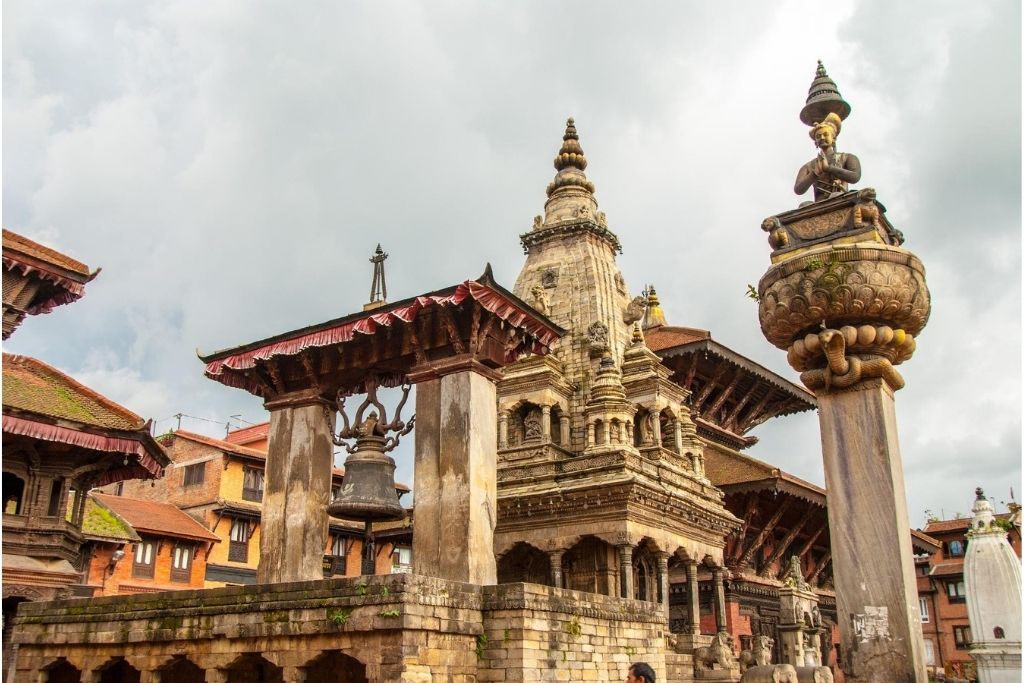
Patan Durbar Square is one of the better-managed historical sites in the area. It has fewer souvenir stalls, making the place less chaotic and crowded.
The Patan Durbar Square is the marvel of Newar architecture. The temples and palaces floored with red-brick tiles add to the antique grandeur of this square.
You will see the locals going out and about and chatting on the Durbar premises as if it is their second home.
Authorities transformed the Royal Palace into a museum called the ‘Patan Museum.’ It once housed the royal family residences and treasures from Nepal’s rich cultural history.
The museum has bronze and copper casts. It also has traditional crafts from Patan’s locals.
Inside the museum, there are three courtyards. They are Mul Chowk, Sundari Chowk, and Keshav Narayan Chowk.
Each yard has its impressive religious shrines. The whole complex boasts several temples, each with exquisite carvings.
Besides the museum, I suggest you visit other attractions of Durbar Square like:
• Krishna Mandir
• Bhimsen Temple
• Vishwanath Temple
• Taleju Bhawani Temple
Entrance Fee: $10 – $15 per person
Kumari Ghar
Kumari Ghar is located in Kathmandu Durbar Square. It is a place with great religious importance as it houses a living goddess called ‘Kumari.’ Kumari Ghar welcomes every traveler with a set of elaborately carved doors.
Kumari makes a public appearance only at a handful of events. Hindus and Buddhists worship her. Make sure to visit Nepal during the festival to see her.
The story of Kumari is fascinating.
Legends have it that King Gunakamdev was friends with Goddess Taleju. They used to play dice every night.
Goddess Taleju helped the king to protect the kingdom. In return, she commanded the king to keep their meeting a secret.
The king’s wife got curious about where her husband would go every night. So, she followed him only to see the Goddess herself.
The Goddess became furious and disappeared. The king pleaded for her return. On this, Goddess Taleju said that she would reincarnate into a young Shakya (Newari) girl. And the king will have to find her.
It is how, till today, the Kumari is selected from a group of girls. These girls possess characteristics like a specific date of birth, physical attributes, etc.
To be a Kumari, the girl has to go through many tests. Her tenure begins as the Royal Kumari until she gets her first mensuration if she passes all the tests.
People say that getting a glance at her brings good luck.
Boudhanath Stupa
Boudhanath Stupa is another Buddhist pilgrimage site listed as a UNESCO World Heritage Site. It is also known to be the largest stupa in existence.
The eyes of Buddha at Boudhanath have been looking over Kathmandu since the 14th century.
The Boudhanath area was once a trade route between India and Tibet. It also became a base camp for Tibetan refugees fleeing China’s oppression. Because of this, Boudha is heavily influenced by Tibetan Buddhism.
Thousands of pilgrims walk around the stupa daily, spinning the prayer wheels as they go. On the side of the stupa is Guru Lhakhang Gompa. Visiting this Gompa is a must, too, as it is one of the oldest monasteries in the Boudha area.
The monastery has statues of Guru Padma Sambhava, Amitabh Buddha, and Arya Avalokiteshwara. As a whole, Boudhanath is a great site to witness authentic Buddhist culture. You can also experience ritual activities.
Restaurants and cafes serve local Nepalese and international cuisines around Boudhanath. The eateries present good food with the best views of the stupa. The only thing to consider is the skyrocketing prices.
Entrance Fee: $2 per person
Swoyambhunath Stupa (Monkey Temple)
Swoyambhunath, also known as the Monkey Temple, is one of the holiest sites of Nepal. It is located atop a hill overlooking Kathmandu.
You need to climb the 365 steps to reach the top of this UNESCO World Heritage Site. You will encounter some smart monkeys who are not afraid of humans. Try to maintain distance, and DO NOT tease them.
You can take a taxi to the hill’s base if you do not want to climb the stairs. The entrance of the stupa has a fountain. People believe that if you succeed in throwing the coin inside the pot, your wishes will come true.
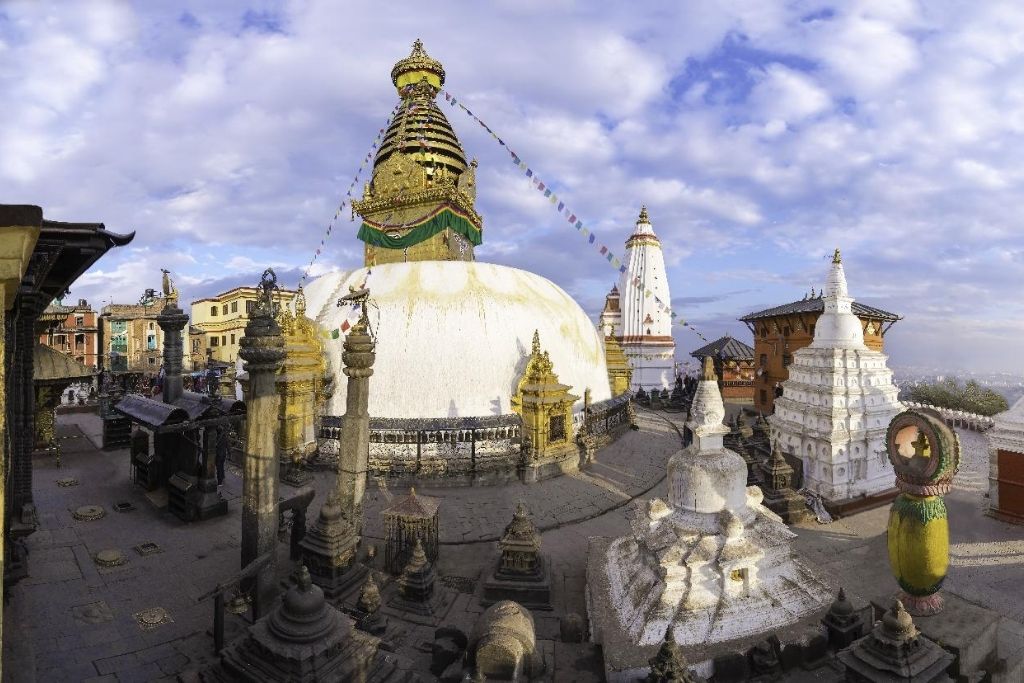
You can see a massive domed stupa with a spire painted with the image of Lord Buddha’s eyes once you reach the top. Prayer wheels and other small shrines and temples encircle the stupa.
The site can be a bit crowded. The hymn ‘Om Mani Padme Hum’ plays in the background, and the scent of incense sticks creates a calming vibe.
As a Buddhist, I suggest you chant ‘Om Mani Padme Hum’ while circling the dome three times. Chanting this mantra clears you of your sins and gives you prosperity.
Did I tell you that Swoyambhu has the best view of Kathmandu city?
The best time to visit Swoyambhunath is around 5 PM – 6 PM. The sunset view, the blinking of lights, and the monks’ chanting in the background are beautiful to experience.
I’m sure visiting Swoyambhunath Stupa will make you feel spiritually enlightened.
Entrance Fee: $2 per person
Kathesimbu Stupa
For travelers wanting a quieter option, Kathesimbu Stumpa is a beautiful religious site near Thamel. The place is great if you can’t visit famous sacred sites like Swayambhunath and Boudhanath.
Entrance Fee: Free
Pashupatinath Temple
The Pashupatinath Temple is a famous Hindu religious site. It invites pilgrims from all over the world. The temple’s existence dates back to 400 BC.
This temple has robust religious and spiritual vibrancy. The site is dedicated to Lord Shiva and has over 518 temples inside its premises.
People consider the main temple a masterpiece in Hindu architecture. The reason behind it is its traditional pagoda structure.
One thing to note when visiting Pashupatinath is that the temple welcomes Hindu devotees only. If you are not one, you must take a guide to know which area you cannot enter.
Hiring a guide is also an excellent way to learn more about the history and culture of Pashupatinath. The best time to visit Pashupatinath Temple is in the evening time. It is when Aarati takes place.
Aarati is a ceremony the priests perform. With the chant music playing in the background, the priest lights a flame (Aarati) and passes it around a deity. The incense sticks and camphor are also burned and offered to Lord Shiva.
You will feel captivated by the environment’s energy while attending the Aarati Ceremony.
Pashupati Temple’s riverbank is also a holy cremation area. It is not a sight to see for the faint-hearted. But if you can, you will realize the meaning of impermanence and tragedy.
Entrance Fee: $10 per person
Garden of Dreams
For a laid-back day in Kathmandu, visit the Garden of Dreams. It is a neoclassical garden in Kaiser Mahal, Kathmandu.
Sir Kaiser Shumsher Jung Bahadur Rana owned this garden built in 1920. After his demise, it went to the hands of the Government of Nepal. The government left it neglected.
With support from the Austrian government, the government renovated the site between 2000 and 2007. Even if only half of the original garden remains, the Garden of Dreams is still bliss for the visitors.
The amphitheater-shaped gardens are decorated with greenery. It has beautiful pavilions, fountains, European-styled verandas, pergolas, and birdhouses.
The area also has decorative garden furniture and yellow bamboo trees. It is a very chill place to hang out and escape the fast-paced tour for a day.
Garden of Dreams also has a restaurant called the ‘Kaiser Café.’ This restaurant is a bit pricy, but enjoying a meal or a drink overlooking a picturesque garden will be worth it.
Entrance Fee: $2 per person.
Narayanhiti Palace Museum
The Narayanhiti Palace Museum is on the east side of the Garden of Dreams. The museum was once a palace where Nepal’s royalty resided. The court hosted many important occasions in the state.
Narayanhiti Palace transformed into a museum after King Gyanendra’s fall in 2008. The 2015 earthquake caused damage to the palace walls and gates.
On your visit, the royal throne will maze you. There are 52 late-victorian-styled rooms in the palace, named after the 75 districts of Nepal. The other highlights are the stuffed gharial, tiger, and rhino heads.
The palace also showcases massive portraits of the late royal families. A visit to this museum will make you feel closer to the life of royalty.
I believe you have heard about Nepal’s royal massacre. People believe that Crown Prince Dipendra murdered the Royal family members. Then, he shot himself.
It was a tragic event for Nepal. You can still see the bullet holes in some of the palace’s walls.
A day at the museum will surely help you learn more about Nepal’s history. Mobiles and other electronic devices are not allowed inside the museum. You can get lockers where you can keep your belongings safe.
After your museum tour, I suggest you stroll the palace gardens to feel like royalty.
Entrance Fee: NPR 500 / $4.28
Jhamel
Most of the tourists know about the tourist district Thamel. Thamel has everything to cater to tourists but has become crowded. And if you want to stay somewhere peaceful, you have Jhamsikhel, located in the Lalitpur district.
Jhamsikhel is nicknamed Jhamel since it serves expatriates and has everything from trekker gear and souvenir shops currency exchanges, bakeries, bars, superb restaurants, and sports centers like Thamel.
The only difference is it is more pleasant and less crowded.
Top Activities in Kathmandu
Hike the Shivapuri Nagarjun National Park
Shivapuri Nagarjun National Park offers a great hike some 15 kilometers from Kathmandu’s central areas.
You will hike through the lush green forests and see the Bishnudwar waterfalls. The national park has abundant flora and fauna. If you are lucky, you will see some animals and birds like Kalij Pheasants.
My favorite part of the hike is the scenery. After you reach the Nagi Gompa, you will get the chance to see Kathmandu Valley’s best views. You will also see Langtang Mountain. I mean, that’s a feast for the eye.
You should have a picnic here.
Entrance Fee: NPR 1050 / $9
Sightseeing
Kathmandu is an excellent site for sightseeing. The city is charming if you travel in the autumn (October – December). You will see the blue skies and the city’s best views.
The best places to sightsee in Kathmandu are Swoyambhunath Stupa, Nagi Gompa of Shivapuri National Park, and Kirtipur.
Take a cooking class

Learning and understanding its food culture is a must whenever you travel to a country. It is beneficial, especially when you crave a particular dish, and you won’t just have to crave it. You can make it on your own.
There are many cooking classes in Kathmandu, like Seven Women, Nepal Cooking School, and 2 Sisters Cooking School. These training schools will teach you how to make traditional Nepali dishes. Some Nepali delicacies are Dal Bhat with vegetable or non-vegetable curry, rice pudding (kheer), and dumplings (momo).
Taking a cooking class will surely be an experience that you can put to work in the future.
Cost:
$45 for a 3-hour class at Seven Women
$10 for a momo-making class at Sasane
Secret Food Tour with Backstreet Academy
Want to try some local food in Nepal while exploring the Nepali culture? Then, going on a private food tour is a must.
You will get a friendly guide who will take you to the best yet low-key places to eat. Trust me; you will dream about these foods after you return to your home country.
Backstreet Academy not only provides street food tours but also gives other courses. Mask carving, stone carving, momo cooking, pottery making, and more are some courses.
The company works with competent yet struggling artisans. So you will learn with the craftsmen at their homes or workshops. As the company implies, it is genuinely the real local and Nepal experience.
Wall Climbing at Astrek Park
If you want to do some outdoor activity, wall climbing at Astrek Climbing Wall, Thamel, is necessary. This wall climbing spot is Nepal’s tallest—50 feet high.
It also has bouldering walls for the best-bodied climb experience. Beginners are welcome as they provide climbing courses as well.
Plus, the climbing site has several restaurants to relax and eat.
Cost:
$350 on Sunday to Friday (8 AM – 4 PM)
$450 on Sunday to Friday (4 PM)
$450 on Saturday (8 AM – 8 PM)
If you want to rent climbing shoes, you must pay $1.29, and the harness costs $0.86.
Meditation
Did you know that Hindu gods and ancient rishis came to Nepal for meditation for thousands of years?
Nepal is an ideal destination for meditation retreats. It is because it has strong ties with Hindu and Buddhist traditions.
The good thing about meditation is that it helps rejuvenate your energy level by relaxing you. It is an excellent way of exploring the spiritual side of you.
There are many monasteries as well as private centers that practice meditation in Kathmandu. It will be an excellent opportunity to uplift your philosophy of living in a land.
Some of the best meditation centers in Kathmandu are as follows:
• Art of Living, Shankamul Yoga Park
• Kopan Monastery, Kopan
• Kagyu Institute of Buddhist Studies, Kirtipur
• Sawar Meditation & Yoga Retreat Center Nepal
Shop for Souvenirs
Most places you will visit in Kathmandu have souvenir markets, be it on a footpath or in a showroom.
In tourist hubs Thamel, Basantapur, and Patan, the vendors usually charge a hefty sum to travelers. So, make sure to haggle a lot.
You should also visit the Asan market in Newroad. Asan is located between Thamel and Kathmandu Durbar Square.
Asan is famous for being the bustling market where you can find EVERYTHING! FOR CHEAP!
Even if you do not want to buy anything, just sit at a local teashop, grab a Chiya (tea), and watch the locals bargain. You can also chat with the locals while you sit there. You may learn some new insights about Kathmandu.
If you want to buy trekking gear and Mandalas, then Thamel is the place to go.
Bungy Jumping
Bungy Jumping is one of the most thrilling activities you can do while in Kathmandu. Located 3 hours from Kathmandu, Bhotekoshi’s bungy jumping site is Asia’s third-highest site. It is also one of the world’s longest Bungee Jumps.
Book a trip with The Last Resort for $110. It includes a one-time jump, lunch, and transportation to and from the hotel.
Attend festivals
Kathmandu, being the capital, is the center of celebrations.
Depending on the time of your visit to Nepal, you can look out for festivals such as Tihar (festival of lights) in October-end or November, Nepali New Year in April, Teej (September), Indra Jatra (September), and Dashain (October).
Rato Macchendranath, which takes place in April, is another excellent festival you must experience while in Nepal. I’m saying “experience” because you will be pulling a chariot of the deity with hundreds of other religious followers.
How much money do you need for Kathmandu?
Nepal is one of the most budget-friendly countries to travel to. For example, you can spend around $33-$45 daily in Kathmandu.
It will cover bed and breakfast, lunch, dinner, and transportation facilities for a day.
If you want to save money, you can buy food from the grocery store and cook on your own instead of eating at a restaurant.
Where to stay?
There are great hotels, lodges, and hostels in Kathmandu.
You can get luxurious hotels with swimming pools and catering services. Otherwise, you can get a hostel where you can stay with other backpackers worldwide.
Most hotels are in the Thamel area, although many are scattered throughout the city. Thus, you will have an array of accommodation options to choose from, depending on your budget and preferences.
Luxurious Hotels
• Hyatt Regency
Hyatt Regency is a five-star luxury hotel and resort in Boudha, Kathmandu. It is only five minutes away from Boudhanath.
The hotel provides room service and has a fitness center, spa, pool, and laundry services. There is also a restaurant on-site. The best thing about this hotel is seeing the Boudhanath Stupa from your room’s balcony.
The price of the rooms ranges from $180 per night.
• Dwarika’s Hotel
The Dwarika’s Hotel, located at Batisputali, Kathmandu, is a heritage hotel with unique Nepali architecture. You will see antique sculptures and decorations everywhere.
The hotel is also famous for its friendly staff and delicious food. The swimming pool of Dwarika is also very unique. The whole vibe of the hotel makes you feel like you are stepping back in time.
The rooms range from $230 to $510 per night.
Mid-Ranged Hotels
• Kathmandu Grand Hotel
Kathmandu Grand Hotel, located at Thamel, is a home for every traveler. It is the best spot for you to stay as it is close to many attractions in Kathmandu. The hotel provides free airport pickup services, too.
The rooms range from $230 to $510 per night.
• Nepal Pavilion Inn
It is another hotel in Thamel that has outstanding hospitality and comfortable bedding.
Nepal Pavilion Inn is famous for its warm décor with Thankas everywhere and has a delicious food menu.
The price of the rooms ranges from $22 per night.
Budget Hotels
• Hotel Himalaya Hub
Hotel Himalaya Hub is the best budget hotel with highly attentive staff and good food.
The rooms are big and comfortable. Every room has air-conditioning, a flat-screen TV, a fridge, and a kettle. Now, isn’t that a bang for the buck?
The price of the rooms starts at only $13.
• Tibet Peace Inn
Tibet Peace Inn is a three-star hotel in Thamel with clean rooms and attentive staff.
Price ranges from $15 per night for the deluxe room.
Hostels
Kathmandu also has many hostels for backpackers on a budget. Hostels are perfect for people looking for a great stay while meeting fellow travelers.
• Hostel Funky Monkey
• Hostel Solo Travel Nepal
• Wander Thirst Hostel
Airbnb
Airbnbs are also available in Kathmandu, with prices ranging from as cheap as $10 to $45 a night.
You can choose your stay at apartments or authentic homestays.
Suppose you are looking to escape Kathmandu’s hustle and bustle. In that case, you should book your stay at some of Kathmandu’s neighboring cities.
• Hotel Mystic Mountain
Hotel Mystic Mountain is located at Nagarkot, an hour away from Kathmandu. It is a splendid place to enjoy the beautiful scenery of the region’s hills and mountains.
The hotel has a perfect mixture of modern luxury and greenery to relax you. Mystic Mountain also offers a delicious buffet menu. There, you can eat overlooking the Himalayas’ panoramic views.
Do not forget the infinity swimming pool and spa in the hotel!
Price ranges from $57 to $109 per night.
• Park Village Resort by KGH Group
Park Village Resort lies at the foothills of the Shivapuri National Park. It is just a 15-minute drive from the center of Kathmandu.
The only noise you will hear in this place is birds chirping.
Park Village Resort is a must for relaxation, adventure, and entertainment. Oh! You’d love the breakfast buffet, too. Price ranges from $33 to $55 per night.
Where to eat in Kathmandu?
First off, I will suggest some restaurants that offer excellent Nepalese cuisine. What’s a tour to Nepal if you do not eat Nepali food daily right?
Some of the best restaurants that offer Nepalese food are:
- Jimbu Thakali Restaurant
- Lete Restaurant
- Achaar Ghar
If you are looking for a pleasing experience with French, Russian, European, and Fusion cuisine, go to:
- The Old House Restaurant
- Roadhouse Café
- The Chimney Restaurant
- OR2K
- La Dolce Vita
Or, if you want to go to some local eateries to try some Nepalese dishes and snacks while saving some bucks, eat at:
- Nandini Food Court (for Newari Food)
- Yangtaru Restaurant (for the best Chicken BBQ)
- Narayan Dai ko Masangalli Momo (for the best MOMO in town)
You will also find many street foods like momos, kebabs, rolls, sandwiches, pagodas, and whatnot at Thamel.
Do not forget to try the Lassi at Indrachowk when you are in Asan.
Nightlife of Kathmandu

Kathmandu is famous for having booming nightlife. The experience meets every party lover’s expectations. From live music and acoustic open-mic nights to DJs, Kathmandu has it all.
Especially places around Thamel thrive on parties. It is a city that does not sleep. You will find locals and foreigners walking the streets of Thamel all night.
It is not THAT risky to walk around at night. However, I suggest you do not walk alone in dark alleys. Sometimes, you may encounter a gang fight scene outside a club: IGNORE AND WALK AWAY!
Some of the best places for a party night in Kathmandu are:
- Trisara, Lazimpat
Trisara hosts concerts of well-known artists. The regular acoustic performances are also lovely.
But most of all, the snacks are delicious here. I love the cheese balls and the crispy fried corn, so try it if you decide to party the night at Trisara.
- Purple Haze, Thamel
Purple Haze is a heaven for rock music lovers. Every night, Purple Haze hosts a rock concert for its audience.
The Nepali rockstars will give you some quality performance.
- Prive Nepal and The Common Room, Soaltee Mode
Want to experience a night of clubbing where everyone is well-dressed? Prive Nepal is a club inside the Soaltee Hotel premises famous for having a classy vibe.
Dance the night away and take pictures in front of the “Ended up at Prive” booth.
Just beside Prive is The Common Room. It is where you can wine and dine.
- Lord of the Drinks (LOD), Thamel
Lord of the Drinks is the biggest club in Nepal. The club has the best sound and lighting systems.
LOD gives you a premium clubbing experience with its island bar and bouncers looking out for your safety.
It is best for female party-goers. I believe our genders should not defy who can go partying or not, but harassment does happen a lot at clubs. And LOD’s bouncers ensure that any type of harassment does not occur.
- Irish Pub, Lazimpat
Irish Pub is great for a laid-back night. You can grab a drink and chill at the bar or listen to good live music here.
Things to know
You need to be careful about certain things as a traveler in Kathmandu. We should be aware of and respect the country’s culture while being cautious about our safety.
So here is some extra information that will help make your travel to Kathmandu smooth:
- You should choose a conservative outfit while visiting religious sites to pay respects. Men should wear pants with long shirts or shirts with sleeves. Women should wear clothes that cover their shoulders and knees.
- Always wear a mask to avoid dust.
- Carry a reusable water bottle and only drink bottled mineral water.
- Carry a hand sanitizer and wet wipes.
- Carry a power bank, just in case there might be a sudden power cut.
- Carry a personal medical kit.
- Do not trek alone. Always have a guide or a trekking buddy with you.
- Even though Nepal houses 10 of the world’s tallest mountains, don’t expect to see the mighty Himalayas from Kathmandu wherever you go. Yes, you can see the mountains from Kathmandu; however, you must visit the city in the autumn or spring to see a better view. The views are better from Kathmandu’s neighboring resort towns like Dhulikhel and Nagarkot.
- Avoid the monsoon season. Even though you can travel to Kathmandu all year round, it is best to avoid traveling in the monsoon if you don’t want to get drenched. The roads get flooded, and the beautiful scenery gets covered by clouds.
- Don’t take part in strikes (bandhs). Make sure to read the news and be updated through social media.
SIM Cards
You have two SIM Card companies in Nepal: Nepal Telecom (NTC) and Ncell.
You can get these SIM Cards as soon as you land at Tribhuwan International Airport, Kathmandu. NTC even provides free SIM Cards for tourists. But you will have to buy the data packages.
However, if you wish to buy it outside the airport, it will cost you $1.
You can buy a 1 GB data pack for $5 if you choose NTC. At the same time, Ncell is much cheaper and gives you a 1.2 GB data pack for only $2.
These are everything you need to know about traveling in Kathmandu. You are welcome to comment below if you have any further questions.
Besides, you may also want to explore another beautiful city, Pokhara, in Nepal. Click here to learn all about traveling in Pokhara.

